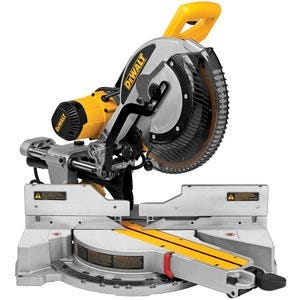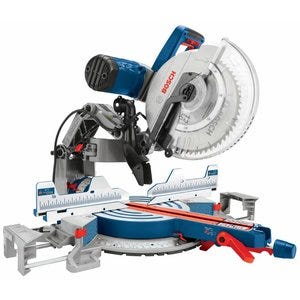The difference between a miter saw and a table saw can be a bit confusing. Miter saws and table saws perform fundamental tasks and achieve common types of cuts, resulting in daily usage for craftsmen. If you want to know how to choose table saws and miter saws for your shop, this guide shows exactly what to look for. It addresses major differences between both types of saws, including their primary applications.
Miter Saw vs. Table Saw
To find the best table saws and miter saws, there are a few things to consider before you begin. For example, the needs of a large shop differ from those of a personal hobbyist. Here are the four aspects to consider while you shop for one that suits you.
Aspects to consider in top-rated table saws and miter saws
- Project size: Do you work with large or small projects?
- Available workspace: How much space do you have to work with?
- Power: Do you require professional-grade tools?
- Versatility: Will you need to perform more advanced cuts?
Small work spaces limit the size of the tool you bring into the shop. Professionals who need to bring their table saws from one job site to another will not want to lug around a bulky table saw when making common rip cuts. They will prefer a mobile solution that gives adequate power without taking up too much space. Those working in larger spaces, especially on roomy shop floors with high-volume tasks, may prefer the extra power and tabletop space that comes with larger types of table saws.
The same concept applies to miter saws. The home carpenter who wants to make simple angle cuts doesn’t need a complex or expensive piece of machinery. His preferences differ from a woodworker who needs to frequently perform compound cuts. In both situations, the size of the blade also plays a role in the decision. Miter saws with larger blades allow longer cuts without extra material adjustments. Smaller machines use smaller blades, and the whole setup takes up less space. The best table saws and miter saws suit your project’s size and your workshop’s size.
Table Saws

There are three different variations on a traditional table saw. In most home woodshops, table saws stand on their own legs. They often have wheels for mobility around the shop floor. In heavier industrial environments, the legs are replaced with a full cabinet. All the best table saws and miter saws connect with dust management systems, usually with a bag or hose that attaches to the blade.
These home and professional table saws both serve as semi-permanent solutions. Their size makes them difficult to transport without special equipment, and those who need to bring their table saw with them usually use a different solution. Job-site table saws provide similar results for these mobile woodworkers without all the extra weight. These lighter saws don’t have their own bases. You must use them on top of a sturdy workbench or table.
Miter Saw

Unlike table saws, miter saws don’t usually come with stands. They sit on the workbench while you use them, and, in some cases, they come with extension arms for added support. There are two main types of miter saws.
The Basic Miter Saw
Every miter saw should allow you to complete two styles of cuts. You should be able to use the most basic styles to create straight cuts, which slice through the width of a plank of wood at a 90-degree angle. The basic styles also allow you to complete angled cuts. To achieve this, you adjust the angle of the blade over your material and pull the blade down the same way you would with a straight cut. To achieve more advanced cuts, you need a compound miter saw.
The Compound Miter Saw
These tools work like basic miter saws but come with one significant difference. In addition to angle cuts, these saws can be cut with a bevel. The blade tilts into position and locks at the angle you need for your cut. Some sellers break down this style of miter saw into further categories. Advanced versions of a compound miter saw allow you to tilt the blade from its 90-degree starting position in both directions.
Miter Saw vs. Table Saw Uses
Table Saw Uses

There are two types of cuts you can make with a table saw. If you cut a piece of wood with the grain, it’s called a rip cut. If you cut against the grain, slicing the wood in half, that’s a crosscut. No matter what types of table saws and miter saws you use, you should be able to complete this second type of cut on a thin piece of wood. The value of a table saw comes from its ability to handle much longer and much wider materials.
Though a table saw takes up more room than a miter saw, it also handles longer cuts. The best table saws and miter saws include extra shelf space on either side of the blade, and you can use external supports when working with even larger sheets or planks. Home and shop table saws usually have larger surfaces than workbench table saws. Their solid bases support the work surface and often connect with your dust management system to clear the air.
Miter Saw Uses

Miter saws complete a few more styles of cuts than table saws. They perform straight, angled, bevel, and combination cuts. With all these settings, miter saws are a fundamental choice for many woodworkers. Craftsmen use bevel cuts to create hidden seams and crown molding. They use straight cuts for simple sizing cuts that maintain the square end of the wood and angled cuts to create edges that fit together at precise angles.
Unlike table saws, miter saws do not complete rip cuts. You cannot push the wood through this tool. Instead, the miter saw uses the blade’s position to create measured cuts at precise angles. You move the machine’s handles to create the angle and bevel you need before pulling the blade through the surface of the wood.
Using One or the Other
Using a Miter Saw vs Table Saw

Use a miter saw when you need to cut wood into a specific length or at a specific angle. Carpentry projects involving trim and molding benefit from the use of a miter saw instead of a table saw. These tools can also be used to create picture frames and other crafts.
Using a Table Saw vs a Miter Saw
Unlike miter saws, the blade on a table saw stays primarily in one position. You can raise or lower the blade depending on the thickness of the wood with which you work, but the stationary blade does not move during the cutting process. With a table saw you push your wood across the blade. The guards and rails guide the wood to ensure accuracy.

Table saws perform larger and longer cuts than miter saws. They help cut down larger materials, too. While miter saws sometimes come with extensions for the sides, a table saw does not require a larger blade to produce a longer cut. Some table saw and miter saw uses overlap. You can complete short, straight cuts with both machines.
Which Kind of Saw to Buy
Many beginning woodworkers wonder how to choose table saws and miter saws for their shops, and the answer depends on what they want to accomplish. If you’re considering this question, your choice in machine should address a specific challenge. Those who build their shops from the ground up may want to start with a miter saw. These versatile tools complete many of the most common cuts, and they can be used for all sorts of projects.
If you plan to add to an existing collection of power tools, your solution depends on where you will find the greatest benefit. A job-site table saw adds versatility to your setup, but it most adequately supports those who need to spend less time carrying materials. Many at-home projects don’t require this level of mobility, so many woodworkers prefer the added power that comes with a stationary saw.
Final Thoughts
Location and ideal features should be considered when deciding between a Miter Saw and a Table Saw. Mobile craftsmen should consider tabletop options or machines that come with wheeled supports. Those working in the same station may prioritize the inclusion of additional features over added mobility. The most effective options address the size of your project and the locations where you prefer to work.
Shop Miter Saws and Table Saws at Acme Tools.




3 Comments
Wm Leasor
January 20, 2017 at 12:12 pmnice article, thanks
Maurine Shene
May 16, 2018 at 3:04 pmYour site is so fantastic. I’m going to come back here again.
Bird
August 26, 2023 at 12:30 amThank you. MITER SAW it is!
Bird